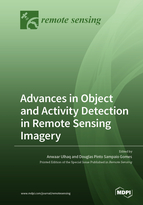Advances in Object and Activity Detection in Remote Sensing Imagery
A special issue of Remote Sensing (ISSN 2072-4292).
Deadline for manuscript submissions: closed (28 February 2022) | Viewed by 25334
Special Issue Editors
Interests: signal and image processing; machine learning; deep convolutional neural nets; data analytics; computer vision; thermal imaging
Special Issues, Collections and Topics in MDPI journals
Special Issue Information
Dear Colleagues,
The widespread availability of drone and satellite imaging data has considerably enhanced air and space-borne monitoring of objects and their activities. Remote monitoring is crucial in various applications areas such as surveillance; border control; rescue operations for disaster management; precision agriculture; environment monitoring; weed detection; land, pest animal, wildlife, and sea-life surveys; and individual or group activity detection. These applications involve automated object and activity recognition.
The recent revolution in deep learning has enabled considerable development in the fields of object and activity detection. Visual object detection tries to find objects of target classes with precise localisation in an image and assign each object instance a corresponding class label. At the same time, activity recognition aims to determine the actions or activities of an agent or group of agents based on sensor or video observation data. It is a very important and challenging problem to detect, identify, track, and understand the behaviour of objects through images/videos taken by various cameras. Together, objects and their activity recognition in imaging data captured by remote sensing platforms is a highly dynamic and challenging research topic. During the last decade, there was significant growth in the number of publications in the field of object and activity recognition. In particular, many researchers have proposed application domains to identify objects and their specific behaviours from the air and spaceborne imagery.
This Special Issue welcomes papers that explore novel and challenging topics for object and activity detection in remote sensing images/videos acquired with diverse platforms.
We want to invite you to submit articles on object and activity detection in remote sensing imagery. We look forward to receiving your submissions which will be carefully reviewed within a much shorter turnaround time than most current journals in this domain.
Dr. Anwaar Ulhaq
Dr. Douglas Pinto Sampaio Gomes
Guest Editors
Manuscript Submission Information
Manuscripts should be submitted online at www.mdpi.com by registering and logging in to this website. Once you are registered, click here to go to the submission form. Manuscripts can be submitted until the deadline. All submissions that pass pre-check are peer-reviewed. Accepted papers will be published continuously in the journal (as soon as accepted) and will be listed together on the special issue website. Research articles, review articles as well as short communications are invited. For planned papers, a title and short abstract (about 100 words) can be sent to the Editorial Office for announcement on this website.
Submitted manuscripts should not have been published previously, nor be under consideration for publication elsewhere (except conference proceedings papers). All manuscripts are thoroughly refereed through a single-blind peer-review process. A guide for authors and other relevant information for submission of manuscripts is available on the Instructions for Authors page. Remote Sensing is an international peer-reviewed open access semimonthly journal published by MDPI.
Please visit the Instructions for Authors page before submitting a manuscript. The Article Processing Charge (APC) for publication in this open access journal is 2700 CHF (Swiss Francs). Submitted papers should be well formatted and use good English. Authors may use MDPI's English editing service prior to publication or during author revisions.
Keywords
- Object detection in aerial imagery
- Action recognition in UAV/satellite imagery
- Activity detection in remote sensing
- Weed detection in remote sensing images
- Border control and surveillance from UAV
- Group activity detection
- Sea- and wildlife monitoring
- Deep learning-based object and activity detection






